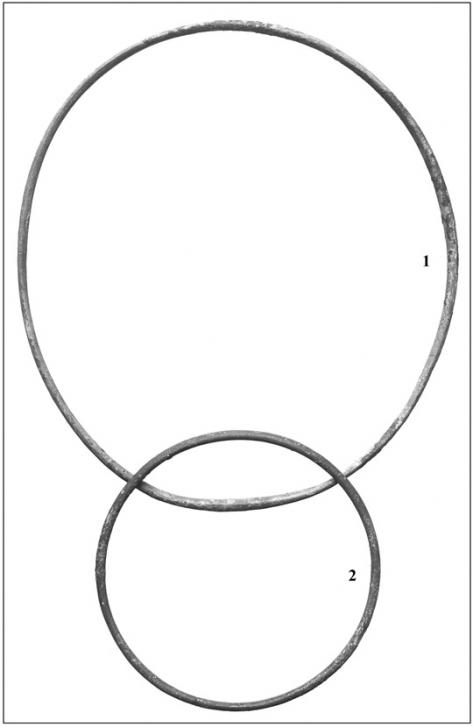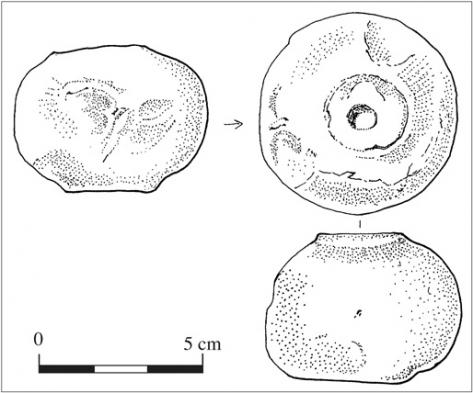Tumulus of the Combe Pévenelle.
Publié 17/10/2018 14:44:00 Modifier 11/07/2019 10:00:27 par 489945901
Isolated, it is established in a wood 200 m west of the summit of Combe Pévenelle, 200 m north of the tumulus of the Mountain and 1500 m north of the three tumulus of Rente-Neuve. Before excavations, the perfectly hemispherical hillock measured 18 m in diameter and had a height of 1.15 m in the center.
#History #Tumulus #Hallstatt # Marsannay-la-cote Period: -2000 years to -300 years.
Situation and current status
Isolated, it is established in a wood 200 m west of the summit of Combe Pévenelle, 200 m north of the tumulus of the Mountain and 1500 m north of the three tumulus of Rente-Neuve. Before excavations, the perfectly hemispherical hillock measured 18 m in diameter and had a height of 1.15 m in the center.
History of excavations
In 1926 and 1927, E. Bertrand, R. Bouilletot, E. Socley, G. Grémaud and E. Guyot fully explored the tumulus from the summit to the natural soil. At each session, they would walk two to three meters into the mound and dump the debris behind them on the previously excavated area. The excavators disappointed in their research counted about thirty burials very fragmented and poor in archaeological material. It is for these reasons that they have published a very summary account of their work, which makes the exploitation of data available today very delicate5 (Bertrand et al., 1927, Nicolardot, 2003, see inventories p. 325).
Structure
The tumulus was built on a limestone base slightly inclined to the east. A trench still visible around the monument allowed the excavators to delimit it precisely.
The central core, consisting of flat slabs neatly interwoven with clay, was covered by a 40- to 50-cm-thick screed consisting of gravel and rock fragments. The latter, wrongly described by the researchers as "liasic sandstone" (Bertrand et al., 1927, pp. 288-289), and according to them from a neighboring region, are actually limestone blocks that are outcropping in this area. We observed many of these elements left by the diggers around the mound. These are native kidneys of a red color whose most common module measures 15 to 20 cm by 10 to 15 cm for 5 to 10 cm thick. They have on one face a rounded profile and on the other an irregular surface which carries various fragments of shells encrusted in the rock. Two samples were studied by Pierre Rat. According to his observations, it is originally a siliceous and ferruginous oolithic limestone. The red coloring on the surface, 2 to 3 mm thick, is due to the oxidation of iron. In addition, we found the same stones in the embankment of a very old, probably east-west hollow road, which passes about fifty meters south of the tumulus.
furniture
A first deep hole of 45 cm executed at the top of the hill gave a large broken vase in coarse black paste ceramics, the collar decorated with three circular grooves traced with the stick. Its filling included human bones, some calcined. Two other fragmented vases have been discovered. However, their content and exact position within the tumor mass are not indicated. These three receptacles interpreted, without more precision, as "incinerations" by the researchers, are not likely to provide us with a valid dating in the absence of a detailed typological description (Bertrand et al., 1927, 286- 287). Place of deposit of the vases: unknown.
With regard to the burials, the fragmentation of the bones and the dispersion of the furniture do not make it possible to recognize with certainty their number. We will simply focus here on indicating the discoveries by keeping the summary description of six burials mentioned by the excavators (Bertrand et al., 1927, 287). Today, the furniture kept at the Archaeological Museum of Dijon has undergone many manipulations and has been mixed with other lots. It could be identified thanks to two unpublished photographs, made by É. Socley, who reproduce the ornaments from excavations. These documents come from the archives of G. Grémaud.
A. Burial 34: "... where appear to have been agglomerated or superimposed, without precise order, 4 burials (debris of 4 different bodies); 1 torque (not found at the Archaeological Museum of Dijon) cast bronze, plain, with, on the periphery, 3 points of burr kept as ornament ... "(Figure 8, n ° 1), 1 filiform bracelet (Fig. 8, No. 2) and 4 armillas (Fig. 8, No. 3).

Fig. 8.
Photograph of the bronze furniture from the tumulus of Combe Pévenelle.
(E. Socley, plate 1/2).
Photograph of the bronze furniture from the tumulus of Combe Pévenelle.
(E. Socley, plate 1/2).
B. Burial 41: "%1 filiform bracelet ... "(Figure 9, n ° 2).
C. Burial 55: "... 1 filiform bracelet ..." (not shown) and an oval ankle ring6 (Fig. 9, No. 1).

Fig. 9.
Photograph of the bronze furniture from the tumulus of Combe Pévenelle.
(E. Socley, plate 1/2).
Photograph of the bronze furniture from the tumulus of Combe Pévenelle.
(E. Socley, plate 1/2).
D. Cote 60: "... a terracotta necklace with a sketch of a human figure (?) ...". This interpretation is false, it is about a fusaiole found isolated, apparently without being in relation with a sepulture7 (Fig. 10). High. : 2.8 cm; diam. : 3.7 cm. According to the typological classification established by B. Chaume, this type 1B2 round-shaped fusillia appears in the Bronze Age and lasts until the first Iron Age. Several similar examples come from Mont Lassois and Bragny-sur-Saône (Chaume 2001: 164). This fusilion and the fragments of five armillas and a tubular bracelet figured on one of the shots of É. Socley (Fig 8, nos 4, 5), not reported by the researchers, was probably unearthed the following year, during a second excavation campaign (Bertrand et al., 1927, 288).

Fig. 10.
Fusaïole (inv.No. 8412) from the tumulus of La Combe Pévenelle.
(drawing J.-R. Bourgeois, Archaeological Museum of Dijon).
Fusaïole (inv.No. 8412) from the tumulus of La Combe Pévenelle.
(drawing J.-R. Bourgeois, Archaeological Museum of Dijon).
In spite of the few observations concerning the excavations, one has the impression that the tumulus has undergone continual reworkings to welcome new burials. These successive burials disrupted the oldest graves (cremation) and scattered bones and furniture. The absence of closed sets and fibula associated with archaeological material composed only of torques and bronze bracelets closed with smooth rushes, makes their dating difficult. However, these annular adornments, frequent at the end of the final Hallstatt and at the beginning of the old La Tène, are attested in funerary contexts in Côte-d'Or, as for example in the mounds of Clair Bois in Bressey-sur-Tille and from La Meusse to Magny-Lambert (Chaume, 2001 pp. 316-324). Armillas, of imprecise dating and generally associated with female burials, meet from Hallstatt D1 and continue to Hallstatt D3 (Baray 2002: 72).
Reference
Jean-Pierre Devaux, " The protohistoric environment of Mount Africa: unpublished data on tumulus excavations carried out in the late nineteenth century. and in the early 20th century. in Couchey (Côte-d'Or) », Archeological Review of the East, Volume 56 | 2007, posted on February 20, 2009, accessed on November 16, 2015.
Author
Jean-Pierre Devaux, amateur archaeologist, 21 rue de la Combette, hamlet of Domois, 21600 Fenay, © All rights reserved.
Link to the original electronic documents:
https://rae.revues.org/5236
Location +/- 4 meters.